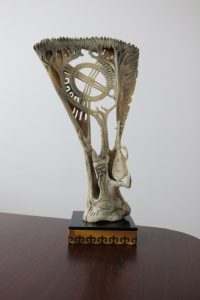




Cattle bone is a multi-valued symbol in Kazakh culture. In some cases it serves as a material for creativity, in others it appears as a “participant” in numerous ritual practices and mythological representations. Among the Kazakhs, the bone is semantically associated with notions of death and its inherent eternal life and vitality. Among all Turkic peoples, the bone is the embodiment of the genetic connection of generations.
These representations are also found among other peoples. For example, the Ob-Ugrian associate the bone with the human life forces, and the Khakass believe that the bone is connected with the human soul.
Animal bones are active “participants” in rituals and games: Horse skulls and other bones (shoulder blade of a ram) in shamanistic and healing practices of Turkic peoples. Ethnographic and archeological findings testify to the once widespread practice of divination with a shovel. The person who qualified for this practice was called zhauranshy (from zhauryn – spade). For divination, the shovel was previously burned in the fire. Divination itself was performed on the basis of the cracks (transverse and longitudinal) and their number on the bone.
In the understanding of Kazakhs, a radial or ulnar bone kari zhilik (semantic translation “an old bone”), which is a kind of symbol of the family hearth, the guardian of travelers and livestock, is deeply sacred. In earlier times, it was hung above the door of the yurt and was considered a “guardian amulet”. Some experts believe that the käri zhilik was an element of the magic of livestock (protection of horses) and also guarded the boundaries of the dwelling.
The sacral understanding of bones was also reflected in traditional crafts. Master carvers süiekshi mastered the secrets of carving animal bones – horns, shoulder blades, shins and ribs of cattle, horses, camels, sheep and saiga – antelopes. Camel bones, which are closest to the color of precious ivory, were extremely popular with artisans. The bones were used for inlays in various furniture and yurt doors, as well as for small items such as combs, hygiene items, etc.


